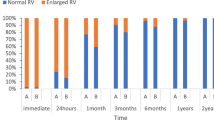Abstract
Prior to initiation of a formal screening program, 30 % of patients referred for device closure of an atrial septal defect (ASD) at our institution had atrial septal anatomy which precluded ASD device closure. This resulted in inefficiencies in workflow, staff utilization, and inconvenience for families. Our objective was to report our experience with an ASD prescreening evaluation/protocol and family consultation process. This is a retrospective study of pediatric patients who underwent a comprehensive ASD prescreening evaluation at Children’s Healthcare of Atlanta between January 2011 and June 2013. The comprehensive prescreening process included a detailed transthoracic echocardiogram and family consultation. Upon establishing a formal prescreening process for patients with secundum ASDs, 138 patients were screened for appropriateness of ASD device closure. At time of prescreening, 40 patients (29 %) were deemed not to be suitable candidates for device ASD closure. In 9 patients (6.5 %), after discussion with the interventionalist, parents elected to pursue surgical ASD closure. A total of 78 patients (56.5 %) underwent successful transcutaneous ASD device closure. In addition, there was a significant discrepancy in the reported size of the ASD between the outside evaluation and the ASD size discovered during the prescreening process. The addition of a prescreening program for transcatheter ASD closure has decreased the incidence of unsuccessful ASD closure from 30 to 10.3 %. The use of a comprehensive evaluation process for ASD device closure improves the likelihood of successful device implantation and permits adequate preprocedural counseling for the patient and family.

Similar content being viewed by others
Abbreviations
- ASD:
-
Atrial septal defect
- ASO:
-
Amplatzer septal occluder
- CHOA:
-
Children’s Healthcare of Atlanta
- GETA:
-
General endotracheal anesthesia
- IFU:
-
Indication for use
- IQR:
-
Interquartile range
- TEE:
-
Transesophageal echocardiogram
- TTE:
-
Transthoracic echocardiogram
References
Butera G, Biondi-Zoccai G, Sangiorgi G, Abella R, Giamberti A, Bussadori C et al (2011) Percutaneous versus surgical closure of secundum atrial septal defects: a systematic review and meta-analysis of currently available clinical evidence. Eurointervention 3:377–385
Crawford GB, Brindis RG, Krucoff MW, Mansalis BP, Carroll JD (2012) Percutaneous atrial septal occluder devices and cardiac erosion: a review of the literature. Catheter Cardiovasc Interv 80:157–167
Delaney JW, Li JS, Rhodes JF (2007) Major complications associated with transcatheter atrial septal occluder implantation: a review of the medical literature and the manufacturer and user facility device experience (MAUDE) database. Congenital Heart Dis 2:256–264
Diab K, Kenny D, Hijazi ZM (2012) Erosions, erosions, and erosions! device closure of atrial septal defects: How safe is safe? Catheter Cardiovasc Interv 80:168–174
El-Said HG, Moore JW (2009) Erosion by the Amplatzer septal occluder: experienced operator opinions at odds with manufacturer recommendations? Catheter Cardiovasc Interv 73:925–930
Mahaptra S (2013) Letter to physician implanters of the AMPLATZER™ septal occluder. http://sjm.com/~/media/pro/resources/product-performance/amplatzer-septal-occluder/aso_physician_letter_16_jan_2013.ashx. Accessed 17 Jan 2013
Mallula K, Amin Z (2012) Recent changes in instructions for use for the Amplatzer atrial septal defect occluder: How to incorporate these changes while using transesophageal echocardiography or intracardiac echocardiography? Pediatr Cardiol 33:995–1000
Moore J, Hegde S, El-Said H, Beekman R, Benson L, Bergersen L et al (2013) Transcatheter device closure of atrial septal defects: a safety review. JACC Cardiovasc Interv 6:433–442
Qureshi AM, Mumtaz MA, Latson LA (2009) Partial prolapse of a HELEX device associated with early frame fracture and mitral valve perforation. Catheter Cardiovasc Interv 74:777–782
Reller MD, Strickland MJ, Riehle-Colarusso T, Mahle WT, Correa A (2008) Prevalence of congenital heart defects in metropolitan Atlanta, 1998–2005. J Pediatr 153(6):807–813
Roberts WT, Parmar J, Rajathurai T (2013) Very late erosion of Amplatzer septal occluder device presenting as pericardial pain and effusion 8 years after placement. Catheter Cardiovasc Interv 82:E592–E594
Silvestry FE, Kerber RE, Brook MM, Carroll JD, Eberman KM, Goldstein SA et al (2009) Echocardiography—guided interventions. J Am Soc Echocardiogr 22:213–231
St. Jude Medical (2012) Amplatzer atrial septal occluder executive summary. http://www.fda.gov/downloads/AdvisoryCommittees/CommitteesMeetingMaterials/MedicalDevices/MedicalDevicesAdvisoryCommittee/CirculatorySystemDevicesPanel/UCM304944.pdf
Taggart NW, Dearani JA, Hagler DJ (2011) Late erosion of an Amplatzer septal occluder device 6 years after placement. J Thorac Cardiovasc Surg 142:221–222
Tobis J, Shenoda M (2012) Percutaneous treatment of patent foramen ovale and atrial septal defects. J Am Coll Cardiol 60:1722–1732
Conflict of interest
There are no conflicts of interest and/or financial disclosures to report for any of the above named authors.
Author information
Authors and Affiliations
Corresponding author
Rights and permissions
About this article
Cite this article
Nicholson, G.T., Vincent, R.N., Petit, C.J. et al. Validation of a Prescreening Program for Transcatheter Atrial Septal Defect Closure. Pediatr Cardiol 36, 1153–1158 (2015). https://doi.org/10.1007/s00246-015-1135-3
Received:
Accepted:
Published:
Issue Date:
DOI: https://doi.org/10.1007/s00246-015-1135-3




